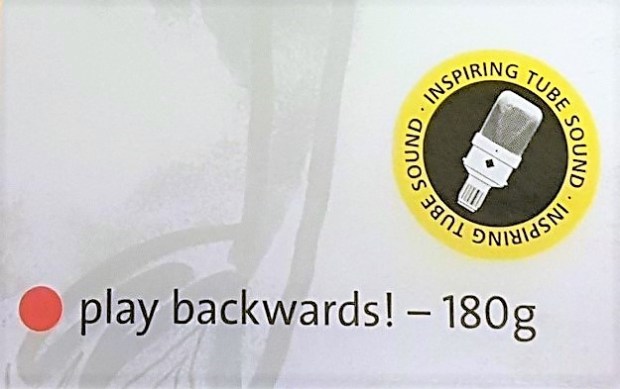 MAURICE RAVEL – oreloB (Boléro) – Carlo Rizzi, Netherlands Philharmonic Orchestra (2012 Tacet backwards-playing 180 gram vinyl)
MAURICE RAVEL – oreloB (Boléro) – Carlo Rizzi, Netherlands Philharmonic Orchestra (2012 Tacet backwards-playing 180 gram vinyl)
Many classical recordings are difficult to play in certain environments, because the parts are written so quietly. If you have ever listened to classical in the car, you’ll know there are times you think the music has stopped just because you can’t hear the subtle instrumentation over the road noise. Put it on headphones and it’s a different story.
Ravel’s Boléro is one such composition. Over its 16 minutes, the music slowly and gently builds from silence. The entire piece is a gradual crescendo. This can be illustrated visually by looking at the entire track in Audacity.
This is where we get technical. According to Techmoan, the greatest Youtube channel dedicated to odd formats and players, LP records suffer from inner groove distortion due to the compression caused by the shorter grooves at the end. Classical music often takes a dip in quality when you get to the end of the record. Boléro always suffered on vinyl releases because it gets abnormally loud at the end, and the compression makes it sound worse. This release of Boléro, on Tacet records, plays from the inside out. This way, the compression caused by the inner groove happens when the music is quietest. When Boléro builds to its full volume towards the end (the outer groove), there is no distortion present. Hence, this release is named oreloB! Both sides work the same way. The side two composition La Valse also begins very quietly and finishes loudly. Because the end distortion is no longer a concern, they were even able to master oreloB a little bit louder than a normal-playing version of the record.
Immediate impressions upon listening to the familiar Boléro again: Wow, Deep Purple ripped off a lot of classical music! It sounds like Boléro was in Jon Lord’s record collection. Even old Star Trek themes — listen carefully and you will hear from where bits and pieces were poached. Cultures clash on this simply beautiful piece with pomp and circumstance. You have certainly heard it before and will recognise its themes gladly.
Sure, you could sidestep all the end groove distortion by simply listening to a CD, but that would take the fun out of it wouldn’t it?
4.5/5 stars





Mind = Blown. That’s fascinating Mike.
LikeLiked by 1 person
Do you have any backwards playing vinyl?
LikeLiked by 1 person
I do. Rob Zombie: Everybody’s Fecking in a UFO.
LikeLiked by 1 person
HAH! Of course Rob Zombie!
LikeLike
Yup, that’s the missing link between Ravel and Rob Zombie.
LikeLike
Even though it’s backwards, I bet you still don’t hear any messages from Satan.
LikeLiked by 2 people
I was wondering if you would hear them if the record was played forward.
LikeLiked by 2 people
Good point, lol!
LikeLiked by 2 people
No messages audible. Sorry to disappoint!
LikeLiked by 2 people
That’s a shame :)
LikeLiked by 1 person
I’m doing a post tomorrow on backwards messages. Hope you enjoy :)
LikeLiked by 1 person
Inner groove distortion sucks. I have the Icon record “Night of the Crime”. Eddie Kramer recorded it and Ron Nevison mixed it, and it sounds totally fantastic until it gets to the end of each side. No cheap CD option available for that album either, so I’m stuck with the vinyl. I deal with it well enough though. Underrated release if a little wimpy at points. This is the song at the end of side one that distorts like hell. It’s probably the heaviest song on the album, which I suppose is better than having a ballad heavily distort and pop. This album is one of those where almost every song is as good as the singles. Killer AOR.
LikeLiked by 1 person
Ah that’s a bummer. In my research for this review I discovered that many classical fans were buying cassettes in the 70s to avoid the groove distortion problem.
LikeLike
Have some more obscure AOR. I want to expose LeBrain to a band he has never heard before. White Sister – Love Don’t Make it Right
LikeLiked by 1 person
Will give it a listen a bit later on!
LikeLike
would the accent aigus become an accent grave when played backwards?!
LikeLiked by 1 person
Geoff, I wrestled with that thought myself. In the end I called it a draw.
LikeLiked by 1 person
That is awesome. I have actually listened to Bolero recently…well Beck’s Bolero as it is one of My Sunday Songs coming up in a few weeks. But this was cooler!!
LikeLiked by 1 person
Ah cool! Beck’s Bolero is classic of course! I actually don’t have it.
LikeLiked by 1 person
Sadly, neither do I for some reason other than digital.
LikeLiked by 1 person
It’s the kind of thing that I KNOW will turn up on a vinyl someday if I keep my eyes open…
LikeLiked by 1 person
Holy shit dude, that is a thingof beauty – and such a cool idea! This. This is why I love records and the people who love them and want to create cool things!
LikeLiked by 1 person
Me too! I know that special edition of Lazaretto by Jack White has a backwards-playing side.
LikeLike
It does!
LikeLiked by 1 person
I think there’s a track in the wee bit in the middle of that one, too?
LikeLiked by 1 person
Yes but I have not DARED play it. Instead I just ripped the audio of someone on Youtube playing it.
LikeLike
Smart. Jack sure does have some cool ideas.
LikeLike